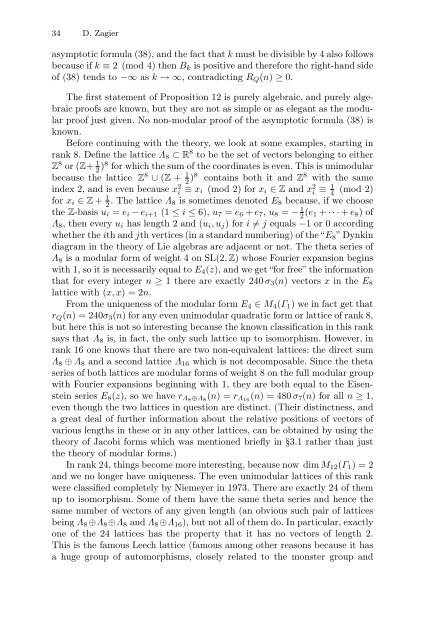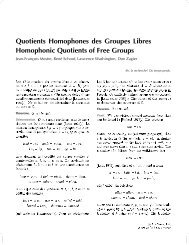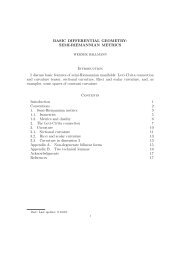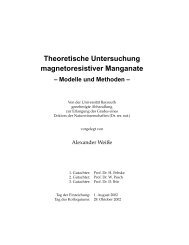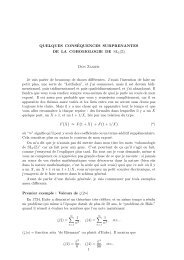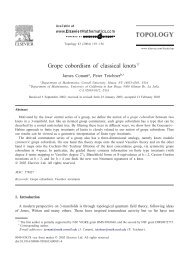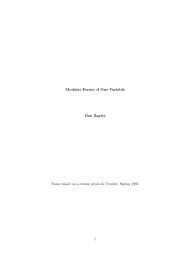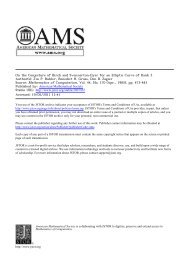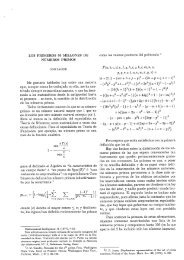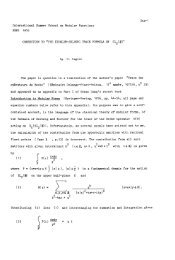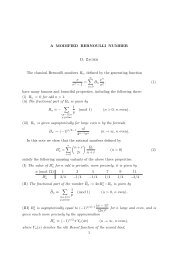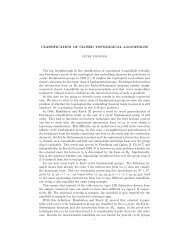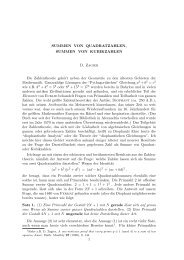Elliptic Modular Forms and Their Applications - Up To
Elliptic Modular Forms and Their Applications - Up To
Elliptic Modular Forms and Their Applications - Up To
Create successful ePaper yourself
Turn your PDF publications into a flip-book with our unique Google optimized e-Paper software.
34 D. Zagierasymptotic formula (38), <strong>and</strong> the fact that k must be divisible by 4 also followsbecause if k ≡ 2(mod4)then B k is positive <strong>and</strong> therefore the right-h<strong>and</strong> sideof (38) tends to −∞ as k →∞, contradicting R Q (n) ≥ 0.The first statement of Proposition 12 is purely algebraic, <strong>and</strong> purely algebraicproofs are known, but they are not as simple or as elegant as the modularproof just given. No non-modular proof of the asymptotic formula (38) isknown.Before continuing with the theory, we look at some examples, starting inrank 8. Define the lattice Λ 8 ⊂ R 8 to be the set of vectors belonging to eitherZ 8 or (Z+ 1 2 )8 for which the sum of the coordinates is even. This is unimodularbecause the lattice Z 8 ∪ (Z + 1 2 )8 contains both it <strong>and</strong> Z 8 with the sameindex 2, <strong>and</strong> is even because x 2 i ≡ x i (mod 2) for x i ∈ Z <strong>and</strong> x 2 i ≡ 1 4(mod 2)for x i ∈ Z + 1 2 . The lattice Λ 8 is sometimes denoted E 8 because, if we choosethe Z-basis u i = e i − e i+1 (1 ≤ i ≤ 6), u 7 = e 6 + e 7 , u 8 = − 1 2 (e 1 + ···+ e 8 ) ofΛ 8 ,theneveryu i has length 2 <strong>and</strong> (u i ,u j ) for i ≠ j equals −1 or 0 accordingwhether the ith <strong>and</strong> jth vertices (in a st<strong>and</strong>ard numbering) of the “E 8 ” Dynkindiagram in the theory of Lie algebras are adjacent or not. The theta series ofΛ 8 is a modular form of weight 4 on SL(2, Z) whose Fourier expansion beginswith 1, so it is necessarily equal to E 4 (z), <strong>and</strong> we get “for free” the informationthat for every integer n ≥ 1 there are exactly 240 σ 3 (n) vectors x in the E 8lattice with (x, x) =2n.From the uniqueness of the modular form E 4 ∈ M 4 (Γ 1 ) we in fact get thatr Q (n) = 240σ 3 (n) for any even unimodular quadratic form or lattice of rank 8,but here this is not so interesting because the known classification in this ranksays that Λ 8 is, in fact, the only such lattice up to isomorphism. However, inrank 16 one knows that there are two non-equivalent lattices: the direct sumΛ 8 ⊕ Λ 8 <strong>and</strong> a second lattice Λ 16 which is not decomposable. Since the thetaseries of both lattices are modular forms of weight 8 on the full modular groupwith Fourier expansions beginning with 1, they are both equal to the Eisensteinseries E 8 (z), sowehaver Λ8⊕Λ 8(n) =r Λ16 (n) = 480 σ 7 (n) for all n ≥ 1,even though the two lattices in question are distinct. (<strong>Their</strong> distinctness, <strong>and</strong>a great deal of further information about the relative positions of vectors ofvarious lengths in these or in any other lattices, can be obtained by using thetheory of Jacobi forms which was mentioned briefly in §3.1 rather than justthe theory of modular forms.)In rank 24, things become more interesting, because now dim M 12 (Γ 1 )=2<strong>and</strong> we no longer have uniqueness. The even unimodular lattices of this rankwere classified completely by Niemeyer in 1973. There are exactly 24 of themup to isomorphism. Some of them have the same theta series <strong>and</strong> hence thesame number of vectors of any given length (an obvious such pair of latticesbeing Λ 8 ⊕Λ 8 ⊕Λ 8 <strong>and</strong> Λ 8 ⊕Λ 16 ), but not all of them do. In particular, exactlyone of the 24 lattices has the property that it has no vectors of length 2.This is the famous Leech lattice (famous among other reasons because it hasa huge group of automorphisms, closely related to the monster group <strong>and</strong>


